#south african jewels
Text
Princess Elizabeth received the South Africa necklace for her 21st birthday in 1947. Five years later, Garrard & Co. removed six stones from the necklace and refashioned them into a bracelet for her coronation.

#queen elizabeth ii#official gift#jewel;necklace#jewel;earrings#british royal family#south african jewels
82 notes
·
View notes
Text

this particular scene makes me think about how unusual the jones family dinner arrangement. children at this era are not usually present at dinner table together with adults. they're usually take their dinner with their nanny/governess at nursery. yet, vivian and colin are allowed to join and eat together with their parents and older siblings
also, in the middle of this very tense dinner scene, if you squint, you could see richard jones glances fondly at his youngest child, colin. my heart cries in joy from watching another member of jones family openly dote on this poor kid 😭
#emma a victorian romance#victorian romance emma#so rare to see this dour old man openly affectionate to his family#rarer than that south african jewel#and the age gap between all joneses siblings#it must be rowdy like a zoo#emma needs to live in a different house after she get married because look at them#they're ready to kill each other
5 notes
·
View notes
Text








Some piccrews of the Gals (Feat Skaar and Hiro)
#art#green goddess (jen)#hate and love are both red (betty)#that's gotta sting (carmilla)#one woman war (lyra)#found in body but lost in mind (skaar)#forgotten jewel (hiro-kala)#walking daydream (gwen)#and her human mode!#i tend to base skaar in more south asian features and hiro more African#since i don't like the troupe that the more 'violent' person is always darker#very buttercup from ppg vibes when they make her latina or smth
3 notes
·
View notes
Text

Bijou ethnique zoulou ::: Timeless Fineries
#bijou africain#collier zoulou#bijou ethnique#collier africain#timeless fineries#bijou traditionnel#collier tribal#bijou zoulou#collier de perles#collier avec pendentif#mode ethnique#african necklace#zulu jewelry#ethnic patterns#south african beadwork#traditional jewel#ethnic necklace#african jewellery#zulu necklace
0 notes
Text
it makes me kinda sad when i think about all the interesting friends and acquaintances my parents used to have who they just... don't talk about anymore, let alone talk to or spend time with, because they went off the deep end with facebook conspiracy theories and antivaxx bullshit and generally turned into weirdo conservatives. like the slavic orthodox monk who used to play football with me and my brother when he came to visit sometimes, or the japanese photographer whose parents sent us cultural exchange gifts every christmas, or the polish woman who toured the world with a dancing/theatre troupe when she was young and later moved to spain and started her own olive farm business, or the american jewish family who lived down the road when we were kids who my mom was best friends with, or my brother's godfather the polish biker gang priest who rode a harley davidson to sermons, or my south african godmother who collected incredible wood carvings of dragons and giraffes and elephants and filled her house with beautiful jewel-colored paintings and ornamental bird cages and brightly patterned and bejewelled throw blankets and rugs and told me about growing up during and post-apartheid and helped me to understand important historical events and social issues we never covered in school and was one of the most unconditionally kind and helpful people i've ever met, or the german family my mom used to spend hours talking to on the phone, or the woman my mom was friends with whose son was trans and who supported my own struggles with gender and sexuality and encouraged me to express myself. i can't even get in touch with most of them because i never got their contact details, and i can hardly ask my parents now. it's just so thoroughly depressing how much life and culture my childhood was filled with and how my parents destroyed that before i was even old enough to fully appreciate it.
#🐉#like i know theres nothing that can be done and i can hardly complain#when like. my own parents are the ones who fucked it all up.#but i just miss so many people i never even really got the chance to know
991 notes
·
View notes
Text
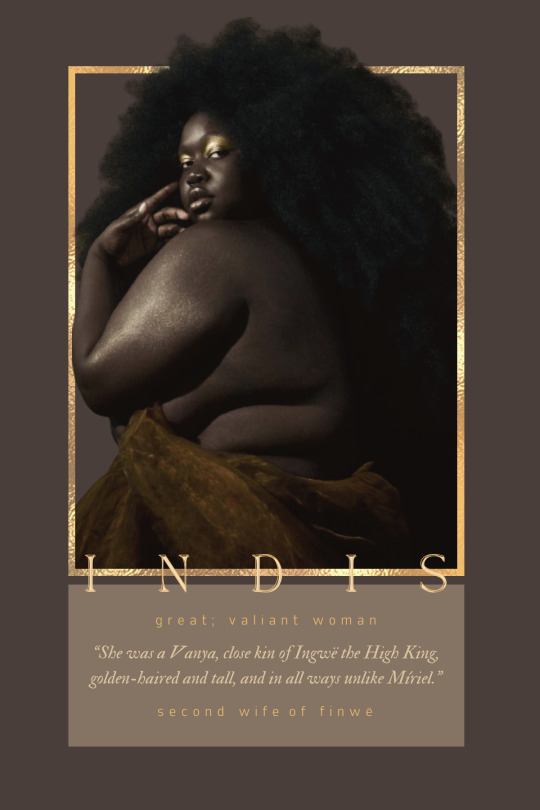
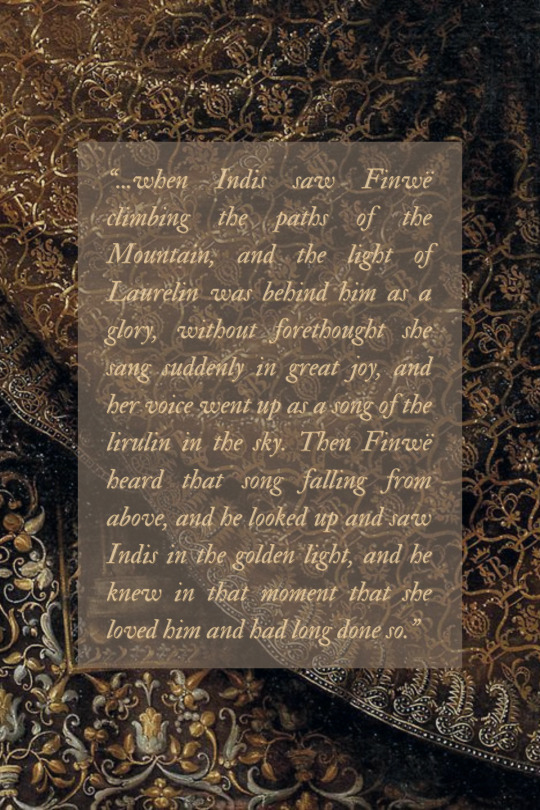


“And when she learned of Finwë all that had befallen since her departure (for she had given no heed to it, nor asked tidings, until then) she was greatly moved; and she said to Finwë in her thought: ‘I erred in leaving thee and our son, or at least in not soon returning after brief repose; for had I done so he might have grown wiser. But the children of Indis shall redress his errors and therefore I am glad they should have being, and Indis hath my love. How should I bear grudge against one who received what I rejected and cherish what I abandoned.’“
- J.R.R. Tolkien, Morgoth's Ring, Laws and Customs Among the Eldar
@finweanladiesweek day 1 » INDIS & MÍRIEL THERINDË
[ID: an edit comprised of four posters in dark and light browns accented with gold and silver.
1: Roseline Lawrence, a ugandan-south sudanese model with dark skin and long coily dark hair. She is plus-size, wearing gold makeup and looking over her shoulder with one hand raised. She is framed by a gold rectangle, with gold text at the bottom reading "indis" in all caps. Below that, text in varying yellow shades reads "great; valiant woman," "second wife of finwë," and "“She was a Vanya, close kin of Ingwë the High King, golden-haired and tall, and in all ways unlike Míriel" / 2: A detail from a painting showing golden embroidered cloth draping down from above. Yellowish-orange text in a transparent brown box reads "“...when Indis saw Finwë climbing the paths of the Mountain, and the light of Laurelin was behind him as a glory, without forethought she sang suddenly in great joy, and her voice went up as a song of the lirulin in the sky. Then Finwë heard that song falling from above, and he looked up and saw Indis in the golden light, and he knew in that moment that she loved him and had long done so" / 3: A detail from a painting showing draped white and silver cloth. Silver text in the same format as Image 2 shows the same passage as the caption of the edit / Thando Hopa, a xhosa-sotho south african woman with albinism. She is looking straight at the viewer and is wrapped in a white robe that falls over her head, though she holds it out of her face. Same format as Image 1, but the frame and text are silver, and the text reads "míriel," "jewel-daughter," "first wife of finwë," and "She was a Noldorin Elda of slender and graceful form, and of gentle disposition, though . . .she could show an ultimate obstinacy that counsel or command would only make more obdurate" /End ID]
#finweanladiesweek#indis#míriel therindë#silmedit#tolkienedit#mepoc#fantasyedit#litedit#tolkiensource#sourcetolkien#oneringnet#the silmarillion#morgoth's ring#the professor's world#brought to you by me#edits with the wild hunt#fc: roseline lawrence#fc: thando hopa#house of finwë#described
68 notes
·
View notes
Text
this is just like when the white settlers in south africa were getting murked bc of africans fighting back against apartheid and all the news stations were like ohhh this is horrible and everyone on social media was like ohhh those poor families got killed maybe steve and jessica wouldve lived if they ain’t move into the areas were black ppl were being removed from their homes to build expensive condos and forced to do jobs into dangerous coal and jewel mines i hateeeee u people
46 notes
·
View notes
Text




I saw one (1) more white knuckles and lost my mind so hard I did all of this for 13 hours and 8 minutes. how are ya'll doing
might fuck around and do this again because there's always more characters
oh yeah also the sonic one isn't new
V specific headcanons under the cut V
[if there isn't a specific one listed i either dont have one in mind]
[Some of these are a mix of very complicated reasons, pretty simple reasons, or no reasons at all. either related to in-game coding or where the original animal came from, anyway i had fun]
1
Sonic: Black(Egyptian)/Asian(Japanese)
Knuckles: Black(Jamaican)/Hispanic(Mayan)/Australian(Aboriginal)
Tails: Asian(Japanese) [it doesn't show in the image but at the moment i've imagined him with prosthetic legs.]
Amy: Black/Asian(Central)
2
Rouge: Latina
Shadow: [Just a mix of so much. man was a genetic experiment there's so much in there. Mostly] African/Asian [though]
3
Silver: Black/Asian(Chinese)/European(Italian) [Albino]
Blaze: Asian(Mix of South-East Asian)
4.1
Cream: European(Irish)
Cheese: Chao(chao)
Jewel: Arabic
4.2
Tangle: Malagasy [Malagasy people have mixed African and Asian ancestry]
Whisper: Asian(Japanese)/Native American
4.3
Vector: Black/European (African American)
Espio: Asian(Japanese)
Charmy: Middle Eastern
4.4
Marine: Australian(aboriginal)/Asian(Japanese) [vitiligo]
Sticks: [Will not let the government or anyone else know her ethnicity. truly an enigma never to be solved. SAD.] Native American/Aboriginal Canadian/European[there was the one guy]
#sonic the hedgehog#knuckles the echidna#miles tails prower#amy rose#rouge the bat#shadow the hedgehog#silver the hedgehog#blaze the cat#cream the rabbit#cheese the chao#jewel the beetle#tangle the lemur#whisper the wolf#vector the crocodile#espio the chameleon#charmy bee#marine the raccoon#sticks the badger#human sonic#human knuckles#human tails#human amy rose#human rouge#human shadow#human silver#human blaze
578 notes
·
View notes
Text
omg you know when you inherit the family money but then suddenly its three years later and you've got nothing left, but someone invites you out anyway for a night of cards and bants and you're like, well, I was always good at baccarat, and you go to the fanciest flat you've ever seen and there's this guy from school who is like, the coolest guy ever, he is a professional sportsman, you've always been a fan. anyway you drink way too much and are having such a good time you forget about all your troubles until its time to get the chequebook out and then you remember oh fuck, I have nothing.
so you wander around hyde park catastrophising in the dark getting more and more desperate and then you decide to do it: go back to the scene of the crime in a complete tizz, and the guy, god he's so handsome, he's so cool, you become obsessed with the idea that you're going to end it all and make HIM witness it if he doesn't help you, even though you know he owes you absolutely nothing, surely this rich bastard can have some convivial spirit for the old school, the old ways?! and so you vomit your trauma over him and he is like lol, k? what's this got to do with me?
and you're FURIOUS so you decide you will do it right then and there, and instead of wiping the smug smile off his face he just looks excited, excited that you're going to blow your brains out, and it snaps you out of it because what the FUCK?! who the fuck is this guy?!
and then it turns out he's AJ Raffles, hero, cad, jewel thief, and he is your downfall, your hamartia, your fatal flaw, and this adventure that starts here and ends on the South African veldt is the greatest and worst thing that will ever happen to you.
"March 15th. 'The Ides of March, the Ides of March, remember.' Eh, Bunny, my boy? You won't forget them, will you?"
#raffles#today is a day of rafflesposting i apologise to no one#crime and cricket#ides of march#the ides of march#tw suicide#bunny manders my beloved#feralposting about raffles as is my right#be gay do crimes#since 1899 baybe
58 notes
·
View notes
Text
Oz Rock bands were big in Brazil in the 1990s. Australian surfers know its breaks. [...] [I]n the past decade [2005-2015] Brazil has had the second fastest rate of migration to Australia [...].
Australia’s connection with Brazil began in 1787 with the First Fleet voyage. This was thanks to the port of Rio’s location in the South Atlantic and a centuries-long British-Portuguese alliance – unique among European powers in the Age of Empires. The First Fleet had three layovers on its relatively cautious eight month voyage from Britain: a week in the Spanish colony of Tenerife in the Canary Islands, a month at Rio in the Portuguese colony of Brazil and a month at the Dutch East India Company’s Cape colony in South Africa. Fleet commander Arthur Phillip had not intended to rest and resupply at Rio but sailing conditions made it prudent to do so. And Phillip’s former service in the Portuguese navy ensured a cordial welcome from Rio’s colonial authorities.
At this time, as Bruno Carvalho writes in Porous City: A Cultural History of Rio de Janeiro (2013), Rio enjoyed rising status within the Portuguese Empire. In 1763 it had been named the new capital of Brazil. In 1808 Portuguese royals fled to Rio to escape Napoleon and remained there at the end of the Napoleonic Wars in 1815. As a consequence, Rio could boast of being the only American city to serve as a centre of European power.
One First Fleet official lamented how little the British knew of Rio. This came to be addressed, as Luciana Martins notes in A Bay to be Dreamed Of: British Visions of Rio de Janeiro (2006), as increasing numbers of British visitors ventured there during the 19th century. Visitors included New South Wales Governor Lachlan Macquarie, and later Charles Darwin – along with thousands of convict and free migrants on board ships calling at the port of Rio.
Writing in Connected Worlds: History in Transnational Perspective (2005), Emma Christopher observed that in Australian history books, travel from Britain to Australia seemed to have been “covered as if in the blink of an eye”.
This inspired her to write of the “watery non-places” of the journey not as voids, but rather as places where much transnational history was lived [...].
[J]ournals by intending Australian colonists such as Macquarie’s wife Elizabeth allow glimpses of colonial Rio through colonial Australian eyes. Elizabeth Macquarie assessed Rio with keen intelligence and, more challengingly – as Jane McDermid has argued in recent research on histories of the British abroad – a callously casual racism.
First Fleet journals tell us that, in 1787, convicts confined to ship at Rio witnessed enslaved West Africans rowing Portuguese fruit sellers around the anchored Fleet transports in decoratively festooned boats.
Convicts overheard and exchanged stories from officials permitted shore leave: stories of the songs of captive West Africans awaiting sale at the port marketplace; of colourful Portuguese Catholic institutions and festivities that were exotic to straight-laced British Protestants. Stories of being forbidden, on pain of death, to venture to hinterland jewel mines. Onshore at Rio, colonial migrants bound for Australia befriended Portuguese colonists, despite the language barrier. They purchased curios. They passed judgement – glowing and harsh – on the people of the Portuguese colony, its natural and built environment, just as Brazilians in turn scrutinised them.
---
Text by: Julie McIntyre. “I Go to Rio: Australia’s forgotten history with Brazil.” The Conversation. 16 September 2015. [Bold emphasis and some paragraph breaks/contractions added by me.]
23 notes
·
View notes
Text
UK/South Africa State Banquet Tiara Predictions
I want to preface this by saying that I think it's very likely we won't get any major jewelry upgrades tomorrow. This is the first state banquet of the new reign and I assume they are going to want to show that it's just business as usual and any big jewelry surprises would get unwelcome coverage. But that also makes me feel like I'm raining on everyone's parade so I'm going to make two predictions for each person with pessimist Tiara Mania on the left and optimist Tiara Mania on the right.
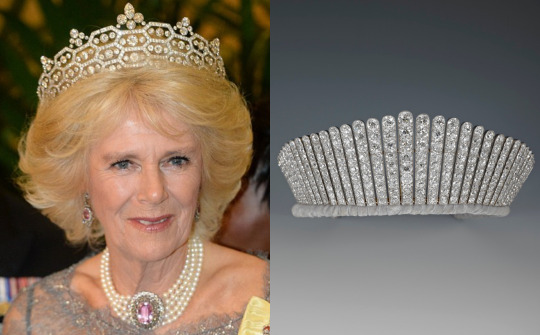
Queen Camilla - Greville Honeycomb Tiara & Queen Alexandra's Kokoshnik Tiara - Queen Camilla is the most likely person on the list to show up in a new tiara and I've long wanted her to wear the Kokoshnik. It was worn by QEII during the last state visit from South Africa in 2010 and the Honeycomb was worn by the Queen Mother for the first time during a state visit to South Africa in 1947 so really there’s a connection with both tiaras. I'm also hoping she wears anything other than one of her pearl choker necklaces because I want to see something different.
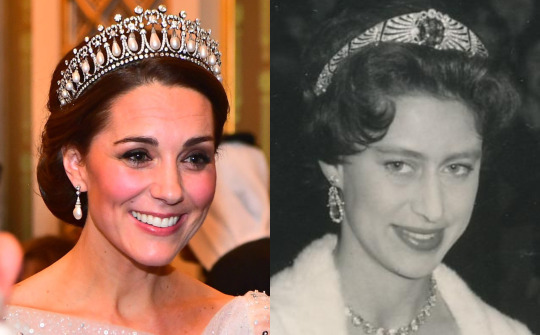
Princess of Wales - Queen Mary's Lovers Knot Tiara & Queen Mary's Sapphire Bandeau Tiara - The Lotus Flower Tiara would be a great choice too but really I just want her to wear anything other than the Lovers Knot. I'm choosing the Sapphire Bandeau because it hasn't been seen in forever and I’m in the mood for something colorful.

Princess Anne - Festoon Tiara & the Queen Mother's Double Meander Tiara - She's already worn the Double Meander once but I really want to see it again and hopefully get better pictures this time.
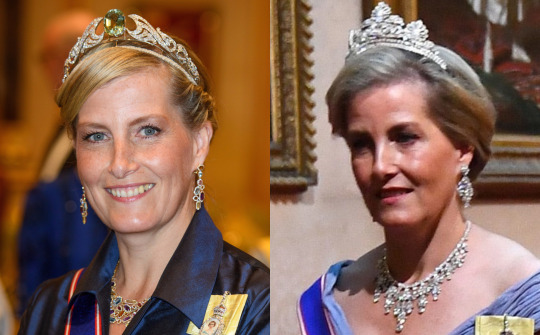
Countess of Wessex - Aquamarine Necklace Tiara & Anthemion Tiara - I can't believe I'm saying this but I actually want Sophie to wear the Anthemion Tiara because I want a better picture of the new configuration.

Duchess of Gloucester - Queen Mary's Honeysuckle Tiara with the emerald center & the Teck Turquoise Tiara - Birgitte is the only person who will wear two tiaras since she will also be attending the Guildhall Banquet on Wednesday so these choices are for the two different events instead of my expectation vs. wish. I want the Teck Turquoise to be second because we usually get better pictures from the Guildhall Banquet and it's been awhile since we've gotten decent ones of this tiara.
Princess Alexandra and Princess Michael of Kent may also attend but it's not a guarantee. Mostly I just want King Charles to change the position of the photographers and/or allow more of them because I'm tired of the grainy shots from a mile away.
Then there's some other jewelry related to South Africa that I'd like to see worn during the state visit.
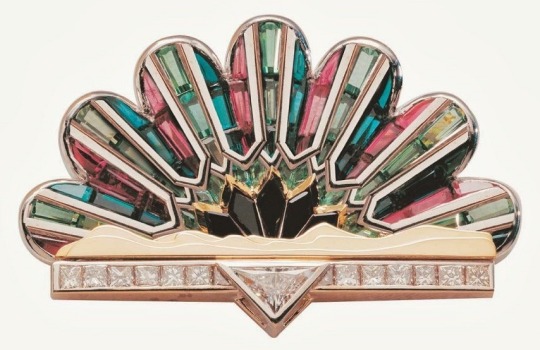
First the Mandela Peacock Sunrise Brooch, which was a gift from Nelson Mandela on behalf of the South African people in 1995. It was made by Johan Louw of Uwe Koetter Jewellers and features diamonds, onyx, and tourmalines set in white and yellow gold. QEII only wore the brooch twice that I can find, during state visits from South Africa in 2001 and 2010. This would be a good choice for Queen Camilla to wear during the daytime events tomorrow which include a visit to the Mandela Memorial Stone at Westminster Abbey.
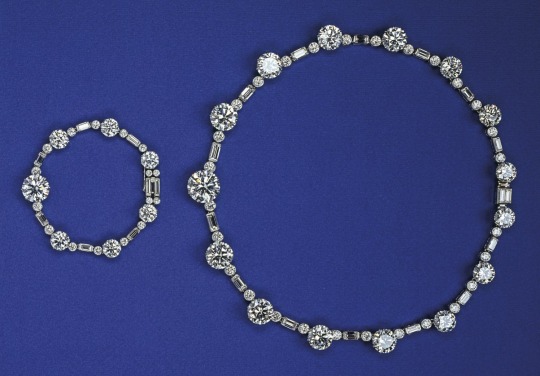
The South African Diamond Necklace & Bracelet or as Queen Elizabeth II supposedly called them her “best diamonds” are some of my favorite of her jewels. They were a gift from the South African government for her 21st birthday in 1947 while she was there with her parents. She later added an extra diamond that was a gift from De Beers and had the necklace shortened to create a bracelet. I'm thinking Catherine instead of Camilla for these just because I like Camilla in bigger necklaces for formal events but really I'd be happy with it on anybody.
What are your tiara predictions?
#Tiara Talk#tiara predictions#British Royal Family#Queen Camilla#Princess of Wales#Princess Anne#Countess of Wessex#Duchess of Gloucester#tiara#Queen Elizabeth#Queen Elizabeth II#United Kingdom
134 notes
·
View notes
Text
The original version of the South African diamond necklace in its case.
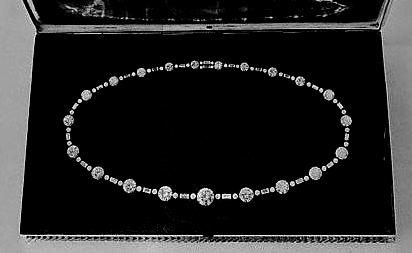
#queen elizabeth ii#official gift#british royal family#picture#thejewelcatalogue#jewel;necklace#south african jewels
37 notes
·
View notes
Photo

Inevitably, they are rich. Extremely rich. Very, very rich. There are the things you can see: the castles, the country estates and the top-of-the-range cars with which to drive between them. There are enough horses to stable an entire stud. There are the exquisite jewels and enormous gems glittering at state banquets.
There are the things you can’t see, too: the sprawling tax-free hereditary property firms and the share portfolio acquired with their annual dividends. There are the works of art in the family’s private collections, rarely, if ever, publicly exhibited. So if we already know all this, why, on the eve of the coronation of King Charles III, investigate the wealth of the British royal family?
The first and simplest answer is that we simply ought to know. From 10 Downing Street to your local district council, the private finances of public servants are fair game for scrutiny where they are derived from public funds. If anything, the need for clarity here is greater: Rishi Sunak and the mayor take money from the public purse only temporarily. The life of the king is funded at taxpayer expense from birth to death.
The second answer is that, to be blunt, the Windsors act as if they have something to hide. The finances are murky as hell, and structured according to a formula that means their annual handouts can only go up, never down. For several decades their shareholdings were owned through a secret shell company at the Bank of England that was immune from national transparency law. The judiciary has sealed their wills from public scrutiny in secret hearings for the past century. This is not the behaviour of a family relaxed about the prospect of an informed citizenry.
The question is not merely how wealthy he is, the question is: how much of the king’s private wealth is derived from his public role? Only once Britain has an answer to that can it discuss the most important question of all: is this really a good way to spend public money?
Just how rich is he?
The first problem with valuing King Charles III’s private wealth is that nobody knows precisely how rich he is, probably including him. Centuries of dynastic marriages with the British aristocracy and the royal houses of Europe have produced a family whose personal history is intertwined with Britain’s national story, and whose personal wealth is inextricable from their public position.
Take the Cullinan III and IV diamonds: two gems cleaved from the largest diamond ever discovered and presented as a gift from the South African government to the king’s great-grandmother Queen Mary in 1910. She wore them in her coronation crown and later as a pair in a brooch, which was left to the queen and then, presumably, the king (the family pays no inheritance tax as long as assets are bequeathed monarch-to-monarch). Elizabeth inherited the brooch in 1953 when Mary died, rather than in 1952 when she became queen. That indicates that the jewels are private. But by modern standards, they were clearly official gifts, so shouldn’t they be national heritage?
The second problem is the culture of extreme deference and secrecy that surrounds the royal family. This is partly a result of a media environment that covers the Windsors as dysfunctional celebrity aristocrats, rather than figures of serious political or constitutional significance. It has created a culture in which the royal institution itself is above normal standards of scrutiny, and where any remotely uncomfortable or probing question, no matter how valid, is ignored or dismissed by default.
Palace responses to questions about the king’s wealth ranged from “we’re too busy, perhaps we’ll respond next week” to “that’s really none of your business”. Questions about which jewels were owned by the state went unanswered. At one point the press office announced it was too busy to respond to further questions until after the coronation. Issued the same day as a palace statement about a celebratory quiche, this did not feel especially convincing. When pushed, the king’s spokesperson said: “Your figures are a highly creative mix of speculation, assumption and inaccuracy.”
The short answer is that, all told, we think Charles is worth at least £1.8bn. But it’s the longer answer, about how the king came to be worth so much, that is more interesting. Excursions to the parliamentary archives to dig out accounts for their hereditary estates unearthed cash payments to the king and his late mother dating back to 1952. That the king and his mother together pocketed more than £1.2bn in annual dividends from the estates (adjusted for inflation) was just as breathtaking as the discovery that they were paying themselves about 10 times more by the end of her reign than they were at the start.
Then you find the gifts. There are the mint-condition stamps from the governments of Cambodia and Laos that have, it appears, been subsumed into the family’s private stamp collection (estimated value: £100m). There are the works of art: an illustrated Bible from the modernist master Marc Chagall, or an etching from Salvador Dalí, both presented to Prince Philip during official visits overseas and both subsequently exhibited as being part of his “personal collection”. The monarchy’s own policy says that gifts from other monarchs “as a general rule” enter the national collection of state heritage, but two diamond necklaces given to the late queen by Saudi kings are mysteriously absent.
You also find lingering traces of the dark moments in Britain’s history. A 100-year-old memo in the British Library records the looting of the city of Lahore in 1849 and the theatrical presentation of plundered diamonds, rubies, pearls and emeralds to an ecstatic Queen Victoria. Once the pride of the British empire, the Koh-i-noor diamond now sits in a vault in some strange, disgraced hinterland: to wear it would be too offensive, to return it to its rightful owners too humiliating.
The historian Brooke Newman discovered a page in a 17th-century share register documenting the transfer of £1,000 of shares in the Royal African Company from the slaver Edward Colston to William III, the first of 14 monarchs to either cultivate the slave trade or harvest its profits. Perhaps revealingly, this was the one dimension of our inquiries to startle the palace into issuing an extended public statement describing how “profoundly seriously” Charles considered the matter.
Does the king need a state grant?
The immediate political question flowing from the king’s wealth is obvious. If the family is this rich, why does it need an annual sovereign grant (currently £86m a year) from parliament? Why are the multimillion-pound payments from the hereditary estates not paid to the Treasury, or at least taken into consideration when setting their annual stipend? Alternatively, if the estates are genuinely private assets, why don’t they pay corporation tax?
After that come much more difficult questions about how a constitutional monarchy behaves in a modern society. Behind the pomp, the wealth and the opulence is a lurking sense of a monarchy designed for the more deferential age of the 19th century, when its purpose was fuzzy but simple: unite and represent the nation.
This, however, is a 21st-century coronation. Whether multimillion-pound salaries and disdain for difficult questions can really unite and represent the values of a modern democracy remains to be seen.
Daily inspiration. Discover more photos at http://justforbooks.tumblr.com
29 notes
·
View notes
Text






Been playing with some piccrews lately and forgot to post em here! Mostly these are just gamma kids de-powered
#art#that's gotta sting (carmilla)#one woman war (lyra)#found in body but lost in mind (skaar)#lost jewel (hiro kala)#walking daydream (gwen)#for gwen its got her normal look and her depowered look#which is what she resorts too when pushing too much energy#also Hiro's burn is swapped but ah piccrews can be limited#in terms of nationality#Bruce/Hulk are white and half jewish on Rebecca's side#Carmilla is Italian and Madripoorian (Malaysian in closest irl terms) on Monica's side#Lyra is a mixture but strongest genes are Greek and Argentinian on Thundra's side#and shadows are a mixture of African/Indian/South Pacific cultures#Gwen is White sjsjsjsjs partially Russian far back on Ross side and part wonder bread
1 note
·
View note
Photo

Lot de deux bracelets africains traditionnels à motifs zoulou ::: Timeless Fineries
https://www.timeless-fineries.com/collections/bracelets-africains-zoulous
timelessfineries.etsy.com
#bijoux africains#bracelets zoulous#bijoux blancs#bracelets traditionnels#timeless fineries#bijoux exotiques#bracelet tribal#bijoux ethniques#perles#mode afro chic#bohème#style hippie#african bracelets#zulu jewelry#beaded bangles#white jewellery#exotic bracelets#ethnic jewels#africa#south africa#zulu fashion#african patterns#tribal jewelry#traditional#pearls
0 notes
Text
Everything the United States does is an investment.
The cultural genocide of Native Americans is within living memory. They have asked for #landback and have been told it would be too difficult, and it has been taken as a joke.
Palestinians converted to Islam 1,000+ years ago. Jewish imperialists and anti-Semites alike were given billions to violently impose an anachronistic Israeli regime, no complaints, no questions asked. The project has been called an "investment" in the United States' interests the region.
In the ancient world, the Islamic nations were the crown jewel. You don't have to look very hard to find ornate extravagances of the ancient Islamic world, wherever they have been permitted to be preserved. In ancient religions, the most effective way to convert peoples to a group's own faith is to be prosperous and attribute this to their faith. And following suit, many nations of Africa converted. [I learned these things in my history classes in uni, so I don't have sources. I may direct you to these professors upon request.]
But everywhere in the world there is any economic prosperity, the United States and the general anglosphere strongly feels an entitlement to having their fingers in that pie. The colonial partitioning of Africa, the South African colony, the colonies in what is today called the US, colonial Australia....
Meanwhile citizens in the US are fixated on oil prices and vote based only on their wallets, perpetuating the state of affairs. The class warfare goes deep in itself but is entirely inextricable.
It's clear to me that Israel as a construct is opportunistic, disingenuous, hypocritical, cynical. And Native Americans will never bribe the US enough to get their/our land back on the US's terms. (Whether I am one of them is subjective.)
#landback#israel#palestine#apartheid#colonialsm#imperialism#capitalism#reminder that the US is millions in debt with the Lakota
4 notes
·
View notes